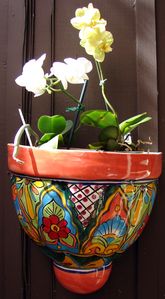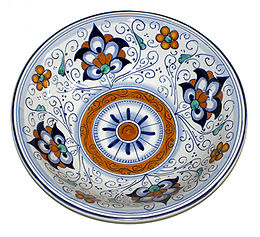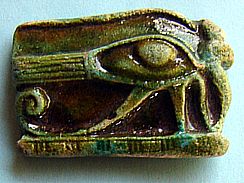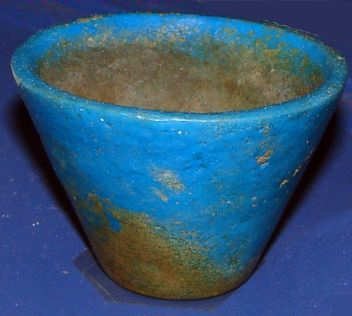
In principle, faience is any earthenware piece coated with a shiny, opaque glaze, such as this modern flower pot from Mexico. However, the word derives from the French pronunciation of the name of a town in Italy, Faenza, famed for such glazes in the 1500s, when a technique of incorporating tin into ceramic glazes produced a distinctive shiny surface (although a limited color palette). Therefore specialists normally restrict the word to ceramics with metallic glazes, especially in the Franco-Italian tradition, like the bowl shown at left below. In recent years the preferred term for such ware is majolica (pronounced mah-YOL-ik-ka, or often mah-JOLE-ik-ka)
In archaeology, the word is used to refer to Egyptian artifacts made of (or covered with) a non-clay-based ceramic substance with a shiny surface. Egyptian faience was used for jewelry or other small items rather than to cover pottery vessels. Some art historians liken the shiny effects preferred by Egyptian faience artisans to those of colored glass.

Egyptians seem to have valued faience for its potential resemblance to rare and valuable stones, particularly lapis lazuli, a semi-precious gem stone. Obviously, very crude faience products (like the modern eye-of-Horus amulet shown below, or the XVIIIth-dynasty faience-glazed cup shown further down the page) were not likely to fool anybody.
The underlying material used in Egyptian faience was silica (in ground quartz and other sand), combined with lime (calcium carbonate derived from burnt limestone) or potash. To this was added a water-soluble alkaline, like sodium bicarbonate. When such a combination is mixed with water, it forms a kind of volatile mud. It has little ability to hold together, and was typically poured or pushed into molds, although skillful artisans could sometimes model it.
Coloring material was usually added. Blue could be made by adding blue or blue-green copper oxide. The result was close to the blue-green color of the semi-precious lapis lazuli, and small pieces may even have been passed off as lapis in some circles. Probably because of the association with lapis, most Egyptian faience was made in this color.

When an object was nearly or entirely dry, it could be gently carved to provide yet finer detail, the limit of fineness being imposed only by the coarseness of the sands used in the manufacture.
Once the artifact had been properly dried (and carved if desired), a layer of glaze (of similar chemical composition) could be added. But it was not always necessary to add a separate layer of exterior glaze. The salts in the ingredients would migrate to the surface in the drying process, and if the dry object was then fired in a kiln (usually to about 900°C) the surface salts themselves were transformed into a glassy surface, although of a slightly "bubbly" texture.

Faience making was easily done on a mass production basis. Once ingredients had been assembled, it was a straightforward process (although one requiring skill) to mix them with water, cast them into reusable molds, dry them, remove them from the molds, carve details as needed, and fire them. Although crude and cheap faience figures survive that were clearly made this way, nearly all were designed as beads or as cheap grave goods.
Far finer efforts included faience inlay work and jewelry of considerable sophistication, sometimes showing exquisite craftsmanship.
It appears that Egyptian techniques of faience manufacture evolved a bit over the centuries. By late pharaonic times, faience often seems to have made use of calcium oxide (burnt lime) rather than calcium carbonate (burnt limestone). This provided a more fine-grained ceramic, which could be yet more finely carved or molded and, of course, could be made to look even more like lapis lapzuli.
Click here for More About Lapis Lazuli.
